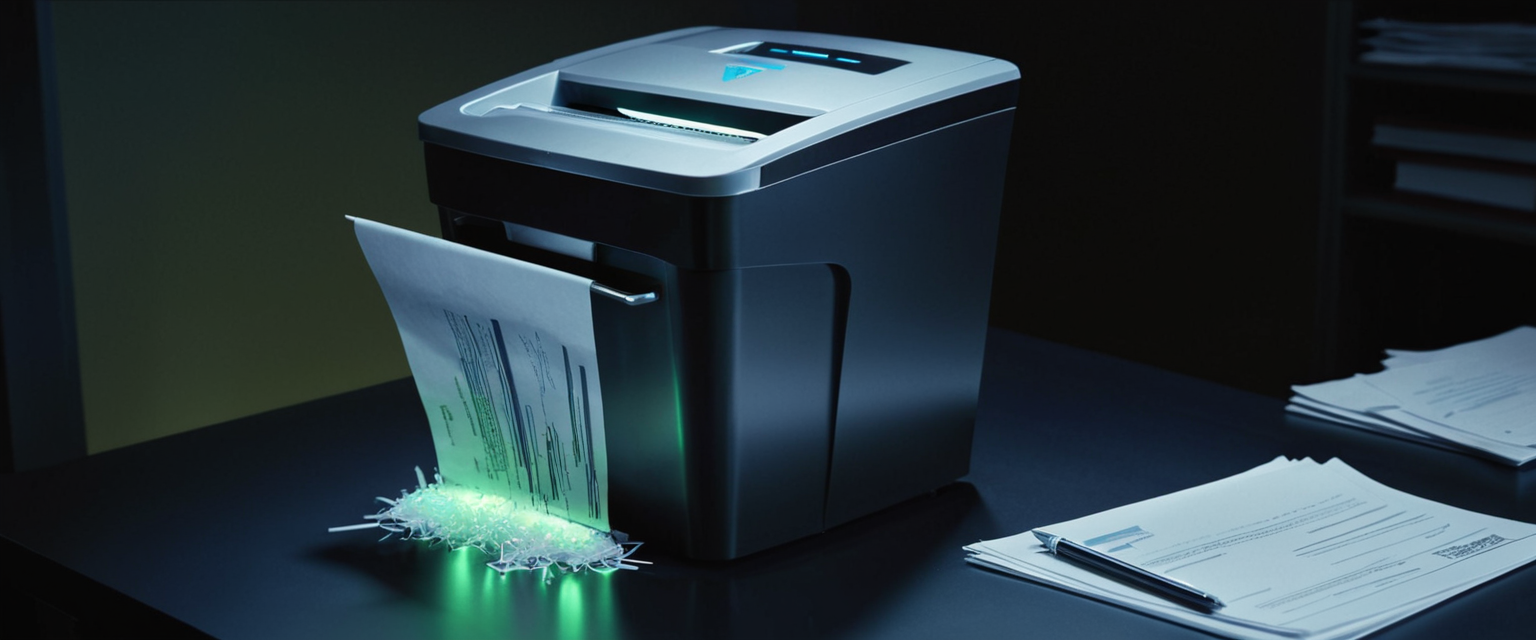
Shredding Day represents a critical moment in an organization’s information security and records management lifecycle, serving as both a practical operation for destroying outdated sensitive materials and a symbolic commitment to data protection principles. This comprehensive analysis examines the multifaceted dimensions of simultaneous paper and digital document destruction, particularly as they relate to financial and medical information that demands the highest levels of confidentiality and regulatory compliance. The convergence of physical document shredding and digital data wiping creates a holistic approach to information lifecycle management that addresses both visible and invisible threats to sensitive data, ensuring that organizations can confidently transition information from active use to permanent destruction while maintaining the trust of clients, patients, and regulatory bodies.
The Escalating Imperative for Coordinated Document Destruction
The foundation for understanding Shredding Day begins with recognizing why such comprehensive destruction protocols have become essential in contemporary business and healthcare environments. According to recent data collected by the Federal Trade Commission, over 1.1 million identity theft reports were received in 2022, and these numbers have continued to climb into 2024 and beyond. The average cost of a data breach in the United States exceeds $8.64 million according to IBM research, with healthcare institutions experiencing particularly severe consequences as they face nearly two data breaches of more finesse than 500 patient records daily, with this figure nearly doubling over the past five years. These alarming statistics demonstrate that improper document disposal remains one of the most preventable yet consequential sources of data exposure, making organized destruction events a fundamental necessity rather than a discretionary practice.
The risks of improper document disposal extend far beyond financial penalty. The Identity Theft Resource Center reported that over 15 million Americans were affected by identity theft in 2023, with a significant portion of these cases traceable directly to improperly discarded physical documents, lost or mishandled digital files, and media containing unencrypted data. When sensitive documents containing Social Security numbers, bank account details, credit card information, or protected health information become accessible through careless disposal, the consequences cascade across multiple dimensions simultaneously. Individuals face unauthorized charges and the long-term burden of restoring their financial health and credit standing, while organizations confront regulatory fines, legal liability, loss of customer trust, and irreparable reputational damage. This reality has transformed document destruction from a clerical function into a strategic business imperative and a fundamental component of organizational risk management.
Understanding Paper Shredding Standards and Security Levels
Paper document destruction operates within a precisely defined technical framework established through international standards that specify exactly how thoroughly documents must be processed to render them irretrievable. The DIN 66399 standard, established by the Deutsches Institut für Normung (German Institute for Standardization), provides the internationally recognized classification system for paper shredding security levels, with seven distinct levels ranging from P-1 to P-7. These levels define the maximum size of shredded paper particles, with the fundamental principle that smaller particles correlate to higher security levels and greater difficulty in document reconstruction.
At the lower security spectrum, DIN P-1 represents general security appropriate for internal documents and non-confidential materials, with strip-cut shredders producing particles approximately 12 millimeters wide. Moving upward, DIN P-2 and P-3 levels provide low to medium security suitable for most business documents, with P-3 representing what many experts consider the optimal security level for typical organizational needs, offering cost-effectiveness while providing substantial protection against document reconstruction. The National Security Agency establishes that effective paper shredding for classified materials requires reducing documents to a maximum edge size of 1 millimeter by 5 millimeters, which corresponds to cross-cut or micro-cut shredding at approximately DIN P-4 or higher security levels.
The highest security levels, DIN P-5, P-6, and P-7, employ advanced micro-cut or particle-cut technology that reduces a standard A4 document into thousands of microscopic pieces, with P-7 level shredding producing approximately 12,053 particles from a single sheet. These highest levels remain essential only for the most sensitive government and military applications. For healthcare organizations handling HIPAA-protected information and financial institutions managing customer financial data, DIN P-3 to P-4 levels typically provide appropriate security while balancing practical operational considerations. The choice of security level fundamentally depends on the nature and sensitivity of the documents being destroyed, with organizations needing to conduct thorough risk assessments to determine which materials require which protection level.
Professional shredding services utilizing mobile shredding trucks equipped with industrial-grade equipment ensure consistent adherence to these standards through specialized machinery and trained operators. Cross-cut shredding technology, considered the most effective form of physical destruction for paper media, creates confetti-like particles that make reconstruction virtually impossible through conventional means. These professional services offer significant advantages over in-house office shredders, which typically produce longer strips of paper that determined individuals could potentially piece back together, creating a false sense of security while leaving actual vulnerabilities in the destruction process.
Digital Data Destruction Methods and Technical Standards
While paper shredding addresses the visible documentary record, digital data destruction represents an equally critical but often overlooked component of comprehensive document protection. Simply deleting files, emptying trash folders, or formatting storage devices proves entirely inadequate for protecting sensitive digital information, as standard deletion operations merely remove file references while leaving the underlying data intact and readily recoverable through forensic techniques. The distinction between secure data disposal—which removes data from easy access but leaves it potentially recoverable—and secure data destruction, which renders data permanently and irretrievably inaccessible, has become crucial to understanding modern information security.
For traditional mechanical hard disk drives, the Department of Defense 5220.22-M standard establishes a three-pass overwrite methodology that has become the gold standard for digital data destruction in sensitive contexts. This method overwrites all accessible storage locations with a series of zeros, ones, and random characters across multiple passes, with the specific pattern ensuring that data remnants cannot be recovered through conventional analytical methods. The DoD 5220.22-M standard remains widely adopted across government, healthcare, and financial sector organizations precisely because its methodology provides verifiable assurance of data destruction that meets stringent regulatory requirements. Implementation of DoD 5220.22-M wiping requires specialized software operating in a bootable environment, ensuring that the entire accessible disk surface receives multiple passes of overwriting before the drive returns to a state suitable for reuse or recycling.
Solid-state drives present fundamentally different challenges for data destruction compared to traditional magnetic hard drives, requiring distinct methodologies and approaches. Solid-state drives employ flash memory architecture that stores data as electrical charges in silicon, making them unaffected by magnetic degaussing techniques and requiring alternative destruction approaches. The most secure approach for solid-state drives involves using whole-disk encryption combined with key destruction—a process whereby data encrypted with full-disk encryption technology like BitLocker or FileVault becomes permanently inaccessible once the encryption key is deleted, without requiring actual data overwriting. Alternatively, manufacturer-provided secure erase utilities communicate directly with SSD firmware to disable access to data storage sections, or organizations may employ physical destruction methods that reduce drives to fragments smaller than two millimeters, meeting the Department of Defense and National Security Agency standards for complete data destruction.
For both hard disk and solid-state storage media, physical destruction represents the only method providing absolute certainty of data destruction that anticipates future technological advancement, particularly the potential emergence of quantum computing techniques that might eventually compromise data previously secured through digital wiping. Physical shredding of storage media employs specialized industrial equipment that mechanically fragments drives into component pieces, with materials then sorted and recycled appropriately. This approach eliminates any possibility of data recovery through any currently available or theoretically foreseeable future technique, making it the preferred method for organizations managing the most sensitive classified, financial, or medical information where future access must be absolutely precluded.
Financial Document Retention and Destruction Requirements
Organizations managing financial records confront complex and overlapping retention requirements that fundamentally shape their document destruction policies and practices. The Internal Revenue Service establishes that financial documents related to tax matters must generally be retained for a minimum of seven years, corresponding to the typical IRS statute of limitations for audits. This retention period applies to profit and loss statements, accounting reports, receipts, checks, and other financial documentation that directly relates to tax obligations and audit exposure. Financial institutions operating under the Federal Deposit Insurance Corporation’s regulations may face differing retention requirements, while organizations subject to Sarbanes-Oxley compliance requirements may maintain documents for significantly longer periods reflecting the extended liability window for publicly traded companies.
The Fair and Accurate Credit Transactions Act imposes specific requirements on organizations handling consumer financial information, mandating secure disposal of consumer financial data to prevent identity theft and fraud. FACTA violations can result in Federal Trade Commission fines of up to $2,500 per violation, creating powerful incentives for organizations to implement thorough document destruction protocols. Many financial services organizations adopt the practice of retaining financial documentation for seven to ten years, with some maintaining permanent archival records of particularly important documents like annual reports and strategic financial plans. This extended retention approach reflects the reality that financial documents may become relevant for litigation, regulatory investigations, or internal business purposes well beyond the minimum legally required retention period.
Credit card receipts represent a special category within financial document destruction requirements, as the IRS explicitly states that retention is not mandatory if other documentation exists registering the transaction, such as deposit records. However, many organizations adopt conservative approaches and retain all receipts for the full seven-year period to ensure complete audit trails and support for reported transactions. Even seemingly routine receipt disposal demands secure shredding procedures, as these documents can provide windows into business operations, customer patterns, and financial affairs that competitors or malicious actors might exploit for corporate espionage or identity theft purposes.

Healthcare and HIPAA-Compliant Document Destruction
The healthcare industry operates within the particularly stringent framework of the Health Insurance Portability and Accountability Act, which establishes comprehensive requirements for protecting, securing, and appropriately destroying protected health information throughout its lifecycle. While HIPAA does not specify exact minimum retention periods for medical records themselves, deferring to individual states to establish these parameters, it does require healthcare organizations to maintain compliance-related documentation for at minimum six years from creation or last update. Covered entities must develop and implement policies and procedures to ensure that Protected Health Information receives appropriate safeguards during destruction, with HHS Office for Civil Rights guidance recommending that paper records be “shredded or otherwise destroying PHI […]so the PHI is rendered essentially unreadable, indecipherable, and otherwise cannot be reconstructed prior to it being placed in a dumpster or other trash receptacle”.
The regulatory stakes for HIPAA non-compliance in document destruction remain severe, with significant historical examples demonstrating enforcement agency commitment to this requirement. In 2009, CVS Pharmacy reached a $2.25 million settlement for improper disposal of protected health information, while Rite Aid paid $1 million for similar violations, and an independent Cornell Prescription Pharmacy faced $125,000 in penalties for improper medical record destruction. More recently, the New England Dermatology and Laser Center agreed to a settlement of $300,640 for improper destruction of medical records and committed to implementing a comprehensive Corrective Action Plan spanning two years. These settlements represent not merely financial penalties but also significant reputational damage, operational disruption, and the necessity of implementing expensive compliance remediation programs.
Protect Your Digital Life with Activate Security
Get 14 powerful security tools in one comprehensive suite. VPN, antivirus, password manager, dark web monitoring, and more.
Get Protected NowHealthcare organizations must establish policies and procedures that address both paper and electronic protected health information, with destruction methods calibrated to match the sensitivity of specific document types and patient populations. Electronic protected health information requires clearing and purging techniques, with HHS guidance recommending destruction through disintegration, pulverization, melting, incinerating, or shredding. For electronic data, the distinction between deletion and true destruction becomes critical, as standard deletion operations leave data recoverable through forensic examination. Healthcare organizations utilizing shared cloud infrastructure must enter into Business Associate Agreements explicitly addressing data destruction responsibilities, ensuring that third-party vendors maintain appropriate safeguards and ultimately verify destruction through Certificates of Destruction documenting the time, date, method, and personnel involved in the destruction process.
Regulatory Frameworks and Compliance Integration
Secure document destruction operates at the intersection of multiple regulatory regimes, each imposing distinct but overlapping requirements that organizations must navigate simultaneously. The General Data Protection Regulation establishes a “right to be forgotten” or right to erasure, requiring that organizations delete personal data when it is no longer necessary for its original purpose, when individuals withdraw consent, or when processing becomes unlawful. The GDPR specifies that such erasure requests must be honored “without undue delay,” interpreted as approximately one month, with organizations having broad responsibility to notify other processors and controllers that a data subject has requested erasure. This represents a fundamental shift from traditional document retention models, imposing affirmative destruction obligations triggered by data subject requests rather than merely permitting destruction at the end of predefined retention periods.
State-level regulations in California and other jurisdictions impose additional requirements beyond federal standards, with some states requiring longer retention periods than HIPAA establishes or imposing stricter destruction protocols than federal law mandates. California hospital requirements exemplify this pattern, establishing that hospitals and healthcare providers must retain records for at least ten years, including billings, treatment authorization requests, medical records, and service reports, reflecting state policy judgments that longer retention periods better serve public health and regulatory purposes. These state requirements frequently govern organizations regardless of whether they are explicitly HIPAA covered entities, expanding the scope of document destruction obligations to any entity creating, maintaining, or transmitting personal health information.
Professional shredding service providers operating in this complex regulatory environment have themselves become essential compliance infrastructure. Reputable shredding companies maintain NAID AAA certification, demonstrating compliance with established standards for secure destruction processes including operational security, employee hiring and screening, destruction procedures, responsible disposal, and comprehensive insurance coverage. NAID certified shredding companies undergo scheduled and surprise audits by trained accredited security professionals, ensuring that their practices remain in compliance with all known data protection laws and emerging regulatory requirements. By partnering with NAID certified providers, organizations create a verifiable chain of custody documenting destruction activities and shifting liability for destruction adequacy to specialized service providers subject to independent verification and regulatory oversight.
Encrypted File Storage and Data Protection During Retention
While document destruction represents the ultimate expression of data protection—the complete elimination of information—organizations increasingly recognize that many sensitive documents require protection during their active retention periods through encryption technology and access controls. Encrypted file storage systems utilizing zero-knowledge encryption principles provide robust protection for financial and medical documents that must remain accessible to authorized personnel while remaining inaccessible to unauthorized parties, including the service providers hosting the encrypted data. Zero-knowledge encryption ensures that data is encrypted on the user’s device before transmission to a storage provider, with only the user possessing the cryptographic keys necessary to decrypt data, meaning the service provider literally has zero knowledge of the actual data contents.
This encryption architecture proves particularly valuable for healthcare organizations managing electronic protected health information, as it enables secure cloud storage while maintaining compliance with HIPAA security requirements mandating encryption of data in transit and at rest. The fundamental principle that encryption keys remain with authorized users rather than with storage service providers means that even if malicious actors successfully penetrated storage infrastructure, they would encounter only encrypted data incapable of decryption without possession of the encryption keys. This represents a complete separation between access to the data storage system and access to the actual data contained within, fundamentally transforming the risk model for cloud-based storage of sensitive information.
Organizations implementing encrypted file storage systems must address critical operational questions regarding key management, user authentication, and authorization frameworks. Strong authentication mechanisms like multi-factor authentication, where users must provide multiple forms of verification before gaining access to encrypted systems, significantly strengthen security postures by ensuring that even compromised passwords or credentials cannot independently enable unauthorized access. Role-based access controls ensure that individual users can access only the specific documents necessary for their particular job functions, with system administrators maintaining oversight of these access patterns to detect anomalous activity that might indicate compromise or attempted unauthorized access. Audit logs recording which users accessed which documents at what times create accountability trails enabling organizations to reconstruct security events and understand the scope of potential compromises if breaches occur.
The complementary use of encryption technologies during retention periods and secure destruction upon expiration creates a complete information lifecycle management approach addressing every stage from document creation through final destruction. Documents created with appropriate sensitivity classification immediately trigger encryption and access control implementation, remaining protected throughout their retention period, then proceeding to coordinated Shredding Day destruction activities that permanently eliminate information no longer required. This lifecycle approach represents the current best practice for managing sensitive financial and medical information, balancing the need to retain documents for operational, regulatory, and litigation purposes with the imperative to minimize exposure windows for sensitive information.
Community Shredding Programs and Coordinated Destruction Events
The practical implementation of comprehensive document destruction frequently occurs through community shredding programs that bring specialized destruction capabilities to population-level audiences, enabling individuals and small organizations to access professional shredding services that would be economically impractical to maintain independently. These community events represent significant public health interventions, directly addressing one of the most preventable sources of identity theft and fraud by providing accessible, affordable, and often entirely free opportunities for residents to destroy sensitive personal documents. The AARP “Big Shred NY” program exemplifies this approach, hosting statewide events across New York City, Albany, Rochester, and Long Island during spring months specifically following tax season, when individuals face particular urgency to destroy old tax returns, financial statements, and related documentation.
The operational logistics of successful community shredding events require careful coordination across multiple dimensions. Event organizers must identify appropriate venues with sufficient space and vehicle access for mobile shredding trucks, typically large semi-trucks equipped with industrial-grade shredding equipment capable of processing thousands of pounds of paper per hour. Most mobile shredding services can shred more than 5,000 pounds of paper per hour, enabling events to accommodate large volumes of documents from numerous participants without excessive wait times. Promotion strategies must extend beyond single events to build consistent community awareness about identity theft risks and the importance of secure document destruction, with successful programs utilizing email campaigns, social media, community bulletin boards at libraries and coffee shops, and local media engagement.
Event staffing typically requires recruitment of 4-15 volunteers depending on event scale, with roles including greeters to welcome participants, event coordinators ensuring smooth operations, and support staff managing document collection and directing participants through the process. Successful events emphasize customer service excellence, training volunteers to provide courteous and efficient assistance that makes document destruction as convenient and pleasant an experience as possible, thereby building community engagement and encouraging future participation. Many programs limit participants to three boxes or bags of documents per person, ensuring equitable access and preventing single individuals from consuming disproportionate resources.
The environmental dimension of community shredding events extends beyond simple document disposal to include recycling and waste management practices that align destruction with environmental sustainability principles. After documents are securely shredded through cross-cut shredding technology, the resulting confetti-sized paper pieces are bundled and transported to paper mills for recycling and conversion into new paper products. This recycling process, when scaled across community events, generates meaningful environmental benefits, with data suggesting that recycling one ton of paper can produce resource savings equivalent to approximately 1,400 liters of oil, 26,500 liters of water, and preservation of 17 trees. Beyond environmental benefits, this recycling approach addresses practical waste management challenges, as improperly disposed shredded paper in landfills decomposes and releases methane, a potent greenhouse gas contributing to climate change.
Many community shredding events incorporate fundraising dimensions that extend benefits beyond simple document destruction to support charitable causes within host communities. Participants may be encouraged to make voluntary donations supporting local food banks, youth programs, or nonprofit organizations, with several events specifically structured to raise funds for worthy community causes. This integration of document security with community benefit creates additional incentive for participation while reinforcing civic engagement and social responsibility. For organizations hosting events, community shredding programs generate positive public relations and media coverage, with news stories emphasizing an organization’s commitment to community security and environmental responsibility. This reputation enhancement creates brand-building value that extends well beyond the specific event, with many businesses finding that participation in community shredding events strengthens customer relationships and differentiates them from competitors.

Risk Assessment and Threat Modeling in Document Destruction
The design of effective Shredding Day programs must begin with comprehensive risk assessment that identifies which documents require destruction, the security levels appropriate for different document categories, and the threats being addressed through destruction activities. Financial organizations managing customer banking information, investment records, and credit card data face distinct risks from organized criminal enterprises seeking to establish fraudulent accounts or commit identity theft, requiring that destruction protocols exceed what smaller organizations managing less attractive targets might require. Healthcare organizations managing protected health information face threats not only from criminal identity theft enterprises but also from competitors seeking proprietary information about clinical procedures, patient populations, or treatment outcomes that might inform competitive strategy.
Risk assessment must address both internal and external threats, recognizing that many document destruction failures result from employee negligence or deliberate misconduct rather than external attacks. According to the 2024 Report to the Nations, tips from employees regarding fraud are twice as likely to originate from employees who received fraud awareness training compared to those without such training, indicating that organizational culture strongly influences employee behavior regarding information security. Insider threats represent particular concern in healthcare settings, where employees with access to patient information might face financial incentives to sell or share protected health information, or where departing employees might retain information for subsequent competitive use. Implementing strong access controls, audit logging, employee training, and clear documentation of document destruction policies creates organizational cultures that normalize information security and make inappropriate behavior more easily detectable.
Environmental factors influence document destruction practices and risk levels, with hybrid and remote work arrangements fundamentally altering where sensitive documents exist and how they move through organizational systems. Employees working from home offices may maintain physical documents on home workstations, creating risks of exposure if homes are burglarized, if family members or visitors access documents, or if information is lost during moves or renovations. Digital documents stored on employee personal devices or cloud storage accounts may exist outside organizational IT infrastructure oversight, creating risks of inadvertent exposure through compromised personal accounts or data loss when employees transition employment. Effective Shredding Day programs must address these distributed document risks through clear policies specifying that employees maintain responsibility for securing documents whether working on-site or remotely, with designated collection mechanisms enabling remote workers to return sensitive documents for centralized destruction.
Training and Cultural Integration of Information Security
The ultimate effectiveness of any Shredding Day program depends fundamentally on organizational culture regarding information security and the degree to which employees throughout the organization understand their personal responsibility for protecting sensitive information and appropriately destroying documents when they reach end-of-life. According to Verizon’s 2024 Data Breach Investigation Report, 68% of breaches involved a human element, including social engineering attacks, errors, or misuse, indicating that human factors remain the primary vulnerability in most organizational security incidents. Comprehensive training programs addressing both detection and prevention of information security risks, with particular emphasis on document handling practices, must reach all employees regardless of organizational position, as sensitive documents may be encountered by administrative staff, mailroom personnel, facilities workers, and others not typically considered part of formal information security operations.
Effective training programs teach employees to identify which documents require shredding versus which may be discarded in normal waste streams, with practical exercises enabling staff to develop judgment regarding document classification. Mock exercises simulating decision-making about document disposal help employees understand the consequences of improper document disposal and internalize the importance of appropriate practices. Training must occur not only at initial employment but also at regular intervals thereafter, with annual refresher training ensuring that organizational personnel maintain awareness of security practices and updated procedures. Many organizations incorporate document destruction into broader “clean desk” policies that require employees to secure physical documents in locked cabinets when away from workstations and to immediately and securely dispose of documents no longer required for immediate work.
Beyond formal training programs, organizational policies and procedures must clearly articulate the connection between appropriate document destruction and legal compliance obligations, helping employees understand that proper destruction reflects both ethical responsibility and legal requirement rather than mere bureaucratic procedure. Many employees who might otherwise be careless about document disposal demonstrate substantially greater care when they understand that failure to properly destroy documents containing protected health information can result in HIPAA penalties of $100 to $50,000 per violation, with maximum annual penalties reaching $1.5 million. Similarly, helping employees understand that improper disposal of customer financial information violates FACTA and can expose the organization to FTC enforcement creates personal accountability that motivates compliance. Leadership visibility and modeling of information security best practices significantly influences organizational culture, with executives and managers who visibly participate in Shredding Day activities and openly discuss document security concerns establishing organizational norms that prioritize information protection.
Certificates of Destruction and Audit Documentation
The issuance of comprehensive Certificates of Destruction following shredding events provides essential documentation enabling organizations to demonstrate compliance with regulatory requirements and to establish clear chains of custody for destroyed documents. A Certificate of Destruction documents when destruction occurred, which documents were destroyed, who performed the destruction, witnesses to the process if applicable, and the specific methods used to ensure secure destruction. This documentation serves multiple critical purposes: first, it provides evidence of compliance during regulatory audits, second-party compliance assessments, and litigation discovery processes; second, it enables organizations to track and account for all sensitive documents within their systems, supporting efforts to understand how documents were managed throughout their lifecycle; and third, it shifts liability and responsibility to specialized third-party service providers who maintain professional certifications and insurance coverage.
The specific information included in a Certificate of Destruction should encompass a unique tracking number or identification enabling audit cross-reference, the customer or client name and address, shredding service provider details and contact information, precise time and date of services, the specific destruction method employed (whether cross-cut shredding, digital wiping, physical incineration, or other approaches), the location where service occurred, names of any witnesses to the destruction process, transfer of custody and fiduciary responsibility documentation, and legal statements confirming that services were provided in accordance with industry standards and legal requirements. This comprehensive documentation enables organizations to respond to regulatory inquiries by providing specific evidence of destruction practices and to respond to data subject requests for confirmation of information deletion by referencing specific destruction events and dates.
For healthcare organizations subject to HIPAA, Certificates of Destruction provide essential support for demonstrating reasonable safeguards during the destruction process, addressing regulatory requirements that covered entities document their implementation of policies and procedures for destroying protected health information. These certificates enable organizations to show regulators that destruction was performed by qualified professionals using appropriate methods rather than through improvised or inadequate processes. For financial organizations subject to FACTA requirements, certificates demonstrating timely destruction of consumer information support compliance defense against alleged violations, particularly when destruction occurred through NAID certified providers subject to independent audit verification. Many modern shredding service providers issue Certificates of Destruction digitally, enabling organizations to archive these records within electronic document management systems for efficient retrieval and compliance management.
Emerging Challenges and Future Considerations
The digital transformation of business and healthcare operations continuously creates new challenges for information lifecycle management and document destruction practices. As organizations increasingly operate through cloud-based platforms and utilize software-as-a-service applications, sensitive information may be processed, stored, and replicated across numerous geographically distributed data centers operated by third-party service providers over whom organizations exercise limited direct control. This distributed data environment fundamentally alters destruction logistics, as ensuring comprehensive deletion of information across all storage locations, backup systems, and redundancy mechanisms becomes far more complex than destruction of information in localized on-premises systems. Organizations must develop comprehensive cloud data destruction policies addressing how they will verify that service providers have completely deleted information, with clear service level agreements specifying data destruction responsibilities and requiring providers to maintain appropriate capabilities and certifications.
The potential emergence of quantum computing represents a longer-term threat to the security assumptions underlying current encryption standards, with implications for both protection during retention and confidence in historical destruction. Current encryption standards like AES-256 encryption, while considered extremely robust against classical computing approaches, might become vulnerable to quantum computing attacks that could theoretically decrypt previously encrypted data if adversaries retain encrypted documents and decrypt them once quantum capabilities become available. This possibility has prompted discussions within the security industry regarding “harvest now, decrypt later” attacks, where sophisticated adversaries collect and store encrypted documents with the intention of decrypting them once quantum computing becomes practically feasible. This threat model suggests that organizations managing information that must remain confidential for extended periods may need to employ physical destruction rather than relying on encryption during long retention periods, or to implement cryptographic agility frameworks enabling migration to quantum-resistant encryption standards before quantum computers become practical threats.
The evolving regulatory landscape surrounding data protection and deletion creates ongoing requirements for organizations to update their destruction practices. The European Union’s Digital Markets Act and ongoing GDPR enforcement activities are establishing evolving expectations regarding timely data deletion and transparency about destruction practices that may exceed what currently available technology easily enables. Organizations maintaining data across multiple jurisdictions with varying deletion requirements face particular complexity, as they must understand when data must be destroyed in different regulatory contexts and implement systems ensuring jurisdictional compliance. Some regulatory frameworks establish automatic deletion requirements where data must be purged unless organizations affirmatively demonstrate legitimate grounds for continued retention, fundamentally reversing traditional models where organizations retain data unless regulations explicitly required deletion.

Environmental Considerations and Sustainable Destruction Practices
While security remains the primary consideration driving document destruction practices, environmental impacts of destruction and disposal activities have become increasingly significant in organizational decision-making, particularly among environmentally conscious companies and those subject to sustainability reporting requirements. Paper shredding, while fundamentally less environmentally impactful than numerous other industrial processes, involves energy consumption in operating shredding equipment, transportation of documents to destruction facilities, and subsequent processing and recycling of shredded materials. Shredding equipment energy consumption can be reduced through selection of energy-efficient equipment and optimization of shredding operations to minimize unnecessary running and maximize throughput during each operating cycle. Mobile shredding trucks, while requiring fuel for vehicle operation, often prove more environmentally efficient than transportation of documents to centralized facilities, as the mobile approach consolidates multiple small document volumes into single efficient collection operations.
The recycling of shredded paper addresses the primary environmental concern regarding document destruction, as shredded paper that cannot be recycled ends up in landfills where decomposition produces methane, a potent greenhouse gas. Paper mills that accept shredded material require specialized processing compared to virgin paper manufacturing, but modern recycling infrastructure has developed capabilities to efficiently process shredded paper into new products. This recycling process, when successfully implemented, creates a circular economy where destroyed documents become feedstock for new paper products, reducing demand for virgin timber and associated deforestation impacts. Organizations committed to environmental stewardship should ensure that their shredding service providers maintain relationships with recycling facilities capable of processing shredded materials rather than disposing of them in landfills.
Hard drive destruction raises distinct environmental considerations, as storage devices contain toxic materials including lead, mercury, and cadmium that pose serious environmental and health risks if improperly disposed in landfills. Physical destruction of hard drives followed by component sorting and specialized recycling represents an environmentally responsible approach that enables recovery of valuable materials including copper, aluminum, and rare earth metals while safely managing hazardous components. The electronic waste recycling industry has developed sophisticated capabilities to safely dismantle, sort, and recycle hard drives and other electronic components, transforming what might otherwise become environmental hazards into valuable recovered materials. Organizations should confirm that their data destruction providers maintain appropriate e-waste recycling certifications and practices ensuring that hard drive destruction supports environmental sustainability rather than creating environmental hazards.
Leaving No Trace: Your Final Word
Shredding Day represents far more than a periodic operational activity aimed at clearing unwanted documents from organizational spaces. Rather, it embodies a comprehensive approach to information lifecycle management that acknowledges the fundamental tension between the operational need to maintain sensitive information for legitimate business, legal, and regulatory purposes and the imperative to minimize exposure windows by permanently destroying information no longer required. Effective Shredding Day programs integrate paper and digital destruction into unified security frameworks, recognizing that sensitive information exists in both physical and electronic forms simultaneously and that comprehensive protection requires coordinated destruction of both modalities.
The design and implementation of effective Shredding Day programs demands attention to regulatory requirements spanning HIPAA, FACTA, GDPR, state-level privacy laws, and industry-specific standards, with organizations needing to understand how their particular regulatory environment shapes destruction obligations and timelines. The selection of appropriate security levels for paper shredding, digital data destruction methods, and encryption approaches must reflect the sensitivity of information and the specific threats organizations face, with risk assessment providing the foundation for proportionate resource allocation. Partnership with qualified third-party service providers holding NAID AAA certification or equivalent qualifications provides assurance that destruction meets industry standards and legal requirements, with Certificates of Destruction providing essential documentation supporting compliance demonstrations during audits and legal proceedings.
Looking forward, organizations must anticipate evolving technological and regulatory landscapes that will continue to challenge document destruction practices. The distributed nature of cloud-based data requires new approaches to verification and control of destruction activities. The possibility of future quantum computing capabilities demands consideration of whether current protection and destruction approaches will remain adequate. Evolving regulatory frameworks will likely impose increasingly stringent requirements for transparency about data destruction and potentially automatic deletion triggered by regulatory requirements rather than organizational discretion.
Ultimately, Shredding Day success depends less on the spectacular destruction activities themselves and more on the organizational commitment to information security that Shredding Day represents. Organizations that make document destruction a visible, celebrated, and clearly documented practice communicate to employees, customers, and regulators their serious commitment to protecting sensitive information throughout its lifecycle. This demonstrated commitment to information protection builds customer trust, attracts privacy-conscious clients and patients, and positions organizations as trustworthy stewards of sensitive information in an increasingly information-intensive world where data protection capabilities distinguish leading organizations from competitors. By treating Shredding Day not as an isolated compliance obligation but as a core expression of organizational values regarding information security and customer trust, organizations transform destruction activities into powerful affirmations of their fundamental commitment to protecting the sensitive information entrusted to their care.






